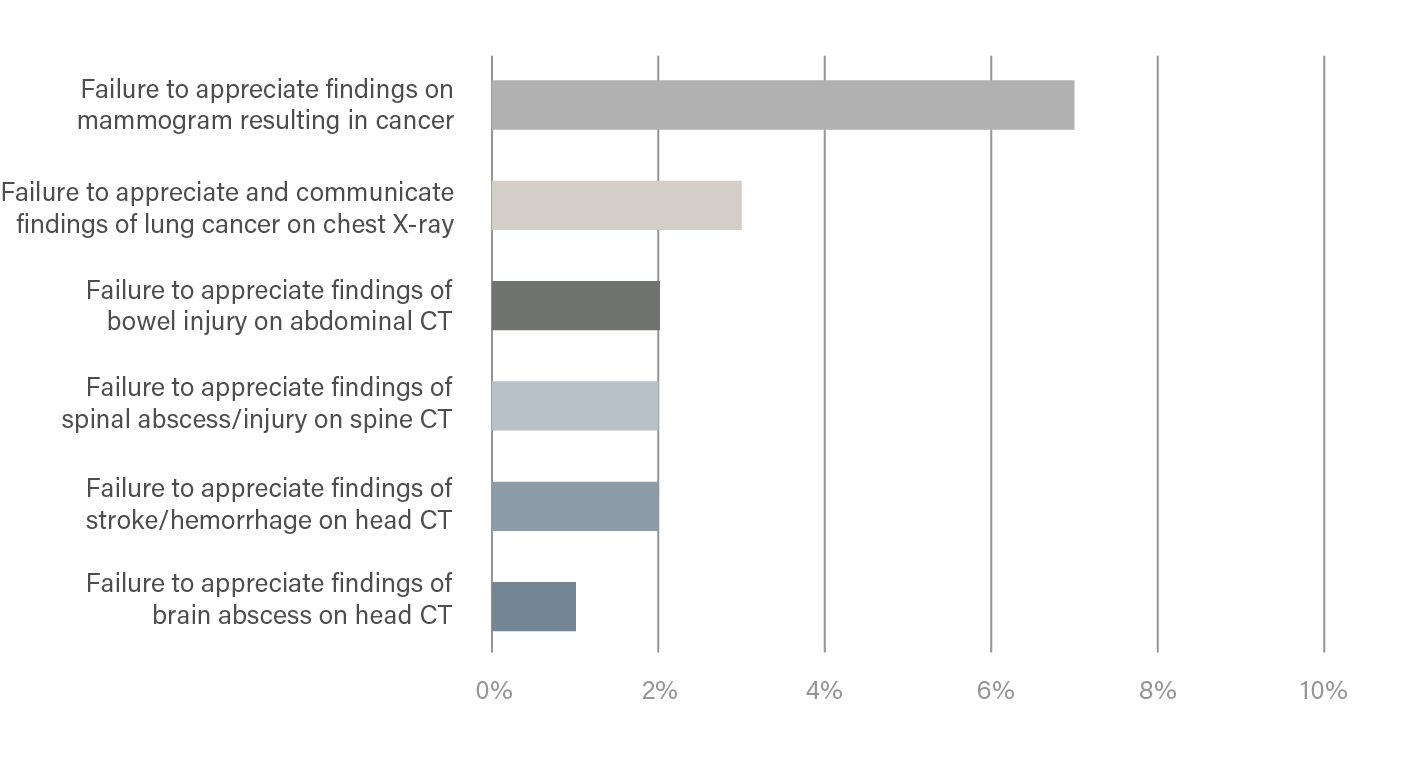Practice of Medicine
article
Reducing the Risk of Misread Mammograms
Failure to appreciate findings on mammogram resulting in cancer accounts for 7% of diagnostic imaging malpractice claims at MagMutual. Despite the advances in mammography techniques, radiologists still face a number of limitations with the images, missing about one in eight breast cancers.

To help radiologists reduce that number, MagMutual’s medical faculty and risk consultants have analyzed our claims data, determined the main causes of diagnostic imaging claims related to misread mammograms resulting in cancer, and developed strategies to improve patient outcomes.
Top Risks
The main causes of claims related to failure to appreciate findings on mammogram resulting in cancer are:
- Failure to Diagnose
- Failure to Rule Out Differential Diagnosis
- Failure to Refer
- Provider-to-Provider Communication
Top Strategies for Reduction
Based on these top risk drivers, implementing the following clinical and operational strategies can help you prevent unexpected outcomes and increase defensibility of a medical malpractice claim:
Clinical strategies
- Palpable complaints are a common source of medical malpractice. All palpable complaints are evaluated with ultrasound and mammography, when appropriate. If the ultrasound is positive or not definitively benign, biopsy the lesion. Limit BIRADS 3 designation to only when strictly appropriate. Short-term follow-up is not protective medically or legally.
- Follow the ACR guidelines, as they are the accepted standards of care regarding breast management. The rules are straightforward and reproducible. Adhere to the BI-RADS lexicon for interpretation and follow-up recommendations. Recommend spot/mag views for concerning findings.
- Radiologists reading mammography should consider annual CME requirements to be at least partly in breast imaging.
Operational strategies
- Fewer mammograms are being performed by dedicated mammographers, which is compromising the quality of the studies. When possible, every effort should be made to employ mammographers. Talk to patients when possible. Many studies have repeatedly demonstrated that radiologists who speak to patients establish a connection and are less likely to be sued.
- If reading remotely, ensure that the monitor resolution (at least 5 megapixel), luminance, contrast threshold and other parameters meet ACR criteria and have FDA clearance. Using a lower standard for a mammography reading station could increase liability in both areas.
Other Top Risks
Though failure to appreciate findings on a mammogram resulting in breast cancer accounts for a significant amount of diagnostic imaging claims according to our data, we’ve identified several other
Risk Drivers by Top Cause
| Key Loss Driver | Top Clinical Loss Cause | Top Non-Clinical Contributing Factor | % of Claims |
|---|---|---|---|
| (A) Failure to appreciate findings on mammogram resulting in cancer | Diagnostic | Communication | 7% |
| (B) Failure to appreciate and communicate findings of lung cancer on chest X-ray | Diagnostic | Communication | 3% |
| (C) Failure to appreciate findings of bowl injury on abdominal CT | Diagnostic | Jousting | 2% |
| (D) Failure to appreciate findings of spincal abscess/injury on spine CT | Diagnostic | Communication | 2% |
| (E) Failure to appreciate findings of stroke/hemorrhage on head CT | Diagnostic | Documentation | 2% |
| (F) Failure to appreciate findings of brain abscess on head CT | Diagnostic | Documentation | 1% |
Risk Drivers by Frequency

Download the full report with indemnity payment information and strategies for all the key loss drivers to help you reduce risk in the top areas that claims occur.
MagMutual PolicyOwners: Log in to view the full report
Not a policyholder? Download Here
Data Collection & Methodology
Data is based on MagMutual closed claims from 2011-2021 and corresponding exposure data. Clinical and non-clinical loss drivers are based on an in-depth review of each claim by a medical professional or clinical risk consultant. Risk reduction strategies are based on input from practicing physicians.
06/24
Disclaimer
The information provided in this resource does not constitute legal, medical or any other professional advice, nor does it establish a standard of care. This resource has been created as an aid to you in your practice. The ultimate decision on how to use the information provided rests solely with you, the PolicyOwner.